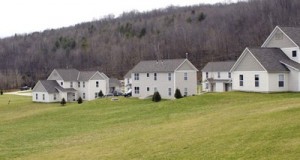
Vermont Housing and Conservation Board. Culver Meadows, an affordable housing neighborhood developed by Housing Vermont with funding from VHCB and other public grants. The project features 20 affordable apartments as well as several affordable home ownership units.
If there is one lesson communities have learned about housing policy, it is that no length of time is long enough when it comes to meeting the need for affordable housing. The twenty and twenty-five year control periods intended to preserve affordability for households with the lowest incomes expired all too soon, leaving many jurisdictions scrambling to find ways to preserve existing affordable housing, and consequently falling farther behind in serving the unmet need. Especially when significant public resources are devoted to a project, it is critical to establish mechanisms to protect that public investment into the future. It is more costly to replace lost housing than it is to preserve it in the first place.
The challenge of serving the lowest income for the longest period has always been an important component of many housing trust funds, and for the housing field in general. Not only is it important to meet current needs, but also to build a supply of housing that will remain affordable over the long term. On the practical side, the challenge comes primarily from finding a way to finance housing so that the income from any individual project will pay for the expenses to build and operate the development. The lower the rents (the main source of income), the more difficult it is to have rents cover expenses.

Vermont Housing and Conservation Board: Culver Meadows’ residents
The Economics of Housing
The expense in buiding and operating housing comes from paying off the loans that were obtained to purchase the land and construct or rehabilitate the housing, including labor, fees, materials, and so forth. Usually, loans are paid off over time, building in a debt structure to the operating costs of the project. Other operating costs, such as property taxes, utilities, maintenance of the structure, wages and so forth must also be paid for over the life of the project. Developers must not only determine whether they can collect the needed funds to pay for the hard costs — what the project will cost to build or rehabilitate, but also whether the project’s income will support its operating expenses over the life of the building, often 30-40 years. If income and expenses don’t match, the project isn’t feasible. A common solution to making and keeping a project feasible is to increase the rents charged so that they cover expenses. But if keeping rents at a level affordable to low and very low income households is a serious goal, other ways must be found to make these projects financially feasible.
Housing trust funds are using a variety of techniques and innovative mechanisms to maintain affordability, including increasing the size of grants, covering operating and maintenance expenses, abating taxes related to the project. Both the Seattle, Washington Levy Program and the Washington Housing Trust Fund support a Maintenance and Operating Fund that enable developments serving the lowest incomes to apply for funds to help sustain these housing opportunities. The New Jersey Balanced Housing Program has set aside $10 million to provide a deep subsidy program for developments serving households earning less than 35% of the area median income.
Equity and Affordability
On the ideological side, there is another challenge: for some, the goal of long term affordability is in tension with a desire to use homeownership to build wealth for low income families. Housing trust funds have dealt with this debate in two primary ways. First, most housing trust funds attach some length of affordability restrictions, or “control period,” to the subsidized unit. The control period can last anywhere from a few years to perpetuity. During this time, the owner is required to sell or rent to a low income household at an affordable price. The control period is typically defined in and enforced through a restrictive covenant on the deed of the property. In addition to seeking specific performance in accordance with the deed restrictions, some jurisdictions also impose financial penalties for non-compliance. In recognition of the ongoing need for affordable housing and , the trend for housing trust funds is to adopt longer control periods, with many imposing affordability restrictions in perpetuity, including housing trust funds in Berkeley, California; Boulder, Colorado, and Burlington, Vermont, and the Vermont Housing and Conservation Board.
Second, housing trust funds have adopted recapture or equity sharing provisions to apply to the sale of an assisted homeownership unit. These policies provide that a share of the appreciated value of the property – after the settlement of a mortgage and other costs – is returned to the entity that administers the housing trust fund. Equity sharing policies are typically defined by formula, with endless permutations, while recapture provisions generally require repayment of the original subsidy, perhaps with indexing. In jurisdictions that do not adopt perpetual affordability control periods, equity sharing and recapture policies are an essential component of helping to replace subsidized units that are lost from the affordable housing stock.
Some housing trust funds have accomplished longer term affordability through community land trusts. Good examples to look at for developing these relationships are the Boulder, Colorado Community Housing Assistance Program; the Burlington, Vermont Housing Trust Fund; and the Vermont Housing and Conservation Board.
For more, see
Shared Equity Homeownership:
The Changing Landscape of Resale-Restricted, Owner-Occupied Housing
Preservation of Affordable Homeownership:
A Continuum of Strategies
